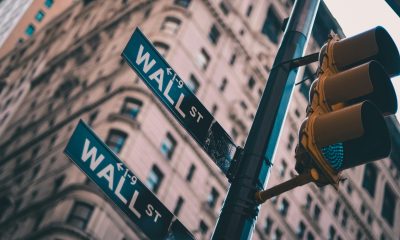Featured
What investors haven’t learned from the 2008 financial crisis
Given the way the markets are moving now, Wall Street gets an “F” because the signs are all around us.

Nine years after the collapse of Lehman Brothers Holdings, Inc., we’re still trying to absorb the lessons of that episode.
It triggered a major market crash, the likes of which we’ve not experienced since 1929. More importantly, it put the real economy into a tailspin. The financial markets didn’t take long to recover. But we’ve ignored the bigger problem: the actual economy. Yet, the 2008 financial crisis explained, even using the style of a movie like The Big Short, fails to capture the essence of the problem.
Now, what we learned from the financial crisis may help us recognize its symptoms. But given the unfettered speculation on Wall Street, we have not learned anywhere near enough to prevent another crash. In fact, it might be fair to say that many “middle-class” citizens have learned that they can get burned in the markets. Nevertheless, the elites appear not to have even sought lessons from the financial crisis, let alone learn anything.
The Lehman Brothers collapse in September of the 2008 financial crisis was the proverbial last straw on the camel’s back. In fact, the subprime financial crisis started a year earlier, on August 9, 2007, to be precise. It was 10 years ago that a major French bank, BNP Paribas SA (EPA:BNP), froze its customers’ withdrawals from three of its funds. That’s how the biggest financial crisis of the past 100 years began.
Many ignore this at their peril
This is a fact that many ignore. BNP realized that the assets these funds held would no longer have any value in the markets. The stock market downturn in 2007 did not immediately translate into a crash. That would take Wall Street to come to terms with the subprime problem. Lehman Brothers was merely the spark. So dire were the effects of the financial crisis, that between 2007 and 2009, the stock markets lost almost half of their value. They would not return to their pre-crisis level on Wall Street until 2012 in the United States.
That’s a brief 2008 financial crisis summary. It took just one bank—and not even the largest one—to realize that the emperor had no clothes. It took a few months longer before the rest of the world would take notice. When they did, they realized that it wasn’t just the clothes the emperor forgot: he had no underwear either.

It’s a hint that many of us have not learned very much about the causes of the financial crisis after all. (Source)
The public, the markets, hardly understood the term “subprime.” We take that for granted now because we have learned the key terminology, or the technical aspects, if you will, of the financial crisis. But we have not learned a more important aspect: How to recognize the signs of trouble.
Subprime mortgages were the canary in the mine
In 2007, subprime mortgages and their mysterious packaging into derivatives were the canaries in the mine. They signaled that something was rotten. Banks were actually trading toxic debt with each other. Serious bankers with serious MBAs and CFA designations decided it was a good idea to fill their institutions’ coffers with bad debt. Such was the level of greed that financial “industry professionals” confused Wall Street for Las Vegas.
It all began in the mid-1990s, when President Bill Clinton deregulated the banking industry, boosting risk. This often-overlooked fact should receive far more attention because President Trump has proposed legislation to deregulate banks to an extent reminiscent of pre-New Deal (1935) levels. The essential ingredient in a financial crash or a gambling disaster and in how much money an individual investor, or gambler, loses depends on one element: risk.
Those who risk little will either win something or lose little. They can go home with some remorse, but they will sleep at night and have sufficient rest to reflect on a better course of action the next time. Those who risk big will win big or lose bigger. If they win, they will fall into a drunken-like stupor of invincibility.
The market today is full of stocks with wild valuations based on little substance—otherwise known as actual profits rather than the promise thereof.
Indeed, the massive stock price increases that have seen the likes of Amazon.com, Inc. (NASDAQ:AMZN) or Tesla Inc (NASDAQ:TSLA) reaching for Olympian heights are the result of greed unfettered by risk. It’s not that the risk has suddenly evaporated. It’s very much there, towering over Wall Street, casting a shadow. But investors, market commentators, and analysts just refuse to see it.
That is the single biggest failure of investors today. They are ignoring the lessons from the financial crisis. Who can blame them? The crisis has taken its toll but the culture has not changed. That’s because it has long legs. It was none other than President Bill Clinton who approved the law that “institutionalized” risk taking. It caused the most trouble for citizens and global markets.
The source of all trouble: The Gramm-Leach-Bliley Act
On November 12, 1999, the Gramm-Leach-Bliley Act (GLBA), also called the Law on Modernization of Financial Services, was approved. The law might as well have been called the “Citigroup Act.” In fact, it was the GLBA that allowed Citicorp to merge with insurance giant Travelers’ Group, giving birth to Citigroup Inc (NYSE:C). GLBA was actually passed a year after the Citigroup merger, after protests that the latter violated the Glass-Steagall Act of 1933, which was intended to protect investors by setting limits on the risks banks could take with their savings.

Glass-Steagall was a pillar of the Roosevelt’s administration’s efforts to confront the Great Depression and to prevent another 1929 Crash. At its core was an insistence on separating investment banks and commercial banks. (Source)
In other words, banks addressing the needs of ordinary citizens—retail and credit for consumption—would be banned from investing in the same way as did the dedicated “investment” banks.
In this way, the Citigroup merger and the GLBA opened the path for banks to use their customers’ savings to boost their stock market activities. In other words, the new law simply fueled the risk beast. In 2009, President Barack Obama tried to reinstate new limits, rebalancing the rules of the game. But forcing big banks to take a step back is not easy. It’s like trying to stop a runaway train. The momentum is simply too strong.
How is this relevant to the 2008 financial crisis? It’s entirely relevant because in the early 2000s in the United States, the commercial banks, flush with ambition and cash, wanted to exploit the bounty. Thus, they engaged the help of millions of Americans, who would not normally invest in the markets or even in housing. But the banks managed to do both.
They allowed low-income families to buy houses in the post 9/11 market frenzy. That would have been a noble pursuit if not for the interest trap that lurked beneath the easy mortgages. The banks offered variable-rate loans (subprime mortgages), leveraged on the value of real estate. Hundreds of smaller credit companies emerged, which held little regard for households’ ability to repay.
They weren’t generous do-gooders. No. They simply knew that once the home—or, rather mortgage—owners would no longer manage to keep up the monthly mortgage payments, they would take over those properties and sell them on the open—and then-booming—real estate market. They basically strangled these households in debts.
But that assumption proved fatal for all concerned. The gamble tripped over itself. The creditors weren’t able to sell the repossessed properties at the prices they had hoped. Meanwhile, the subprime mortgages were sold and packaged into complex financial products, or derivatives, which gullible banks all over the world bought, infecting their entire portfolios with toxic debt. Like any contagion, it spread worldwide.
But that’s still not the major cause of the financial crisis
That’s what we have not learned yet. The major cause was the fact that the signs of trouble had been around for a decade, but nobody recognized them as such. In May 2007, barely a few months before BNP Paribas decide to stop buying subprime debt derivatives, then-Federal Reserve Chair Ben Bernanke declared that the rise in the default rate on mortgage repayments would not be detrimental to the U.S. economy.
That’s what we have not learned yet. The major cause was the fact that the signs of trouble had been around for a decade, but nobody recognized them as such. In May 2007, barely a few months before BNP Paribas decide to stop buying subprime debt derivatives, then-Federal Reserve Chair Ben Bernanke declared that the rise in the default rate on mortgage repayments would not be detrimental to the U.S. economy.
Bernanke and the rest of the Washington establishment, President Bush included, remained under the illusion that the markets had liquidity.

Everyone believed the banks and the economy to be too big to fail. (Source)
We all know what would happen in September 2008. Lehman Brothers declared bankruptcy and sent a subprime shock on the global economy. It was too late. The worst financial crisis since the Great Depression of 1929 was upon the world.
The next big crash is waiting to happen. It might not be caused by subprime mortgages. Yet, there’s plenty of debt around. Subprime auto loans have already produced their first victims and the retail sector, a major engine of the American economy, is enduring losses all over. Look around your suburban neighborhoods and you will notice such household retail names as Saks Inc (NYSE:SKS), JC Penney Company Inc (NYSE:JCP), or Target Corporation (NYSE:TGT) closing shop.
More than that, the same appetite for risk that produced the subprime crisis is pushing stocks beyond reasonable valuations now. Companies like Tesla, or even more clearly, Snap Inc (NYSE:SNAP), “Snapchat,” have risen to incredible prices. Tesla is still flying high—Snapchat has already experienced a dose of reality—but the financial crisis of 2007-08 has taught us that expectations on financial markets can get out of hand.
There, it’s that simple. But once investors shed the expectations in the face of too much reality, they lose trust or confidence. These are difficult to restore. In an interconnected and globalized world like the present one, when a popular stock is exposed for having risen without the finances to back it up, the result is a disaster.
A handful of stocks, when they fail, can trigger a confidence crisis for financial institutions, exposing financial weaknesses, triggering a collapse of the “gambling” or “risk appetite” of investors. In other words, that’s what will cause the next crash.
—
DISCLAIMER: This article expresses my own ideas and opinions. Any information I have shared are from sources that I believe to be reliable and accurate. I did not receive any financial compensation in writing this post, nor do I own any shares in any company I’ve mentioned. I encourage any reader to do their own diligent research first before making any investment decisions.

-

 Africa1 week ago
Africa1 week agoForeign Investor Activity in Morocco’s Equity Market in 2024
-

 Fintech1 day ago
Fintech1 day agoPayPal Under Fire: Excessive Data Collection and Privacy Concerns in Advertising
-

 Biotech1 week ago
Biotech1 week agoJohnson & Johnson’s Tecvayli Combo Shows Breakthrough Results in Multiple Myeloma
-

 Cannabis3 days ago
Cannabis3 days agoTrump Signals Historic Shift: U.S. Weighs Reclassifying Cannabis from Schedule I to III


























You must be logged in to post a comment Login